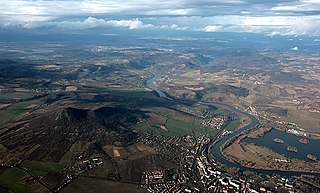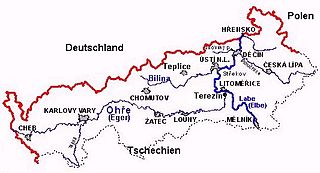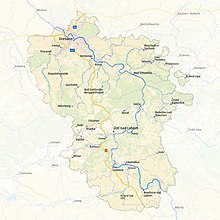
Ústí nad Labem is a city in the Czech Republic. It has about 91,000 inhabitants and is the capital of the Ústí nad Labem Region. It is a major industrial centre and, besides being an active river port, is an important railway junction.

Ústí nad Labem Region or Ústecký Region is an administrative unit of the Czech Republic, located in the north-western part of the historical land of Bohemia, and named after the capital, Ústí nad Labem. It covers the majority of the former North Bohemia province and is part of the broader area of North Bohemia.

Lovosice is a town in Litoměřice District in the Ústí nad Labem Region of the Czech Republic. It has about 8,800 inhabitants. It is an industrial town.

Děčín is a city in the Ústí nad Labem Region of the Czech Republic. It has about 47,000 inhabitants. It is the 7th largest municipality in the country by area. Děčín is an important traffic junction.

Pirna is a town in Saxony, Germany and capital of the administrative district Sächsische Schweiz-Osterzgebirge. The town's population is over 37,000. Pirna is located near Dresden and is an important district town as well as a Große Kreisstadt.

Hřensko is a municipality and village in Děčín District in the Ústí nad Labem Region of the Czech Republic. It has about 300 inhabitants. With an elevation of 130 metres (430 ft) above sea level, it is the lowest situated municipality in the country. Located on the edge of the Bohemian Switzerland National Park, Hřensko is known for many natural monuments, especially for the Kamenice Gorge and Pravčická brána.

Königstein is a town on the river Elbe in Saxony in Germany. Königstein lies in the Sächsische Schweiz-Osterzgebirge District and had a population of 2,089 in 2018. It includes land on both banks of the Elbe, but the centre and most of the town lies to the south of the river. The Königstein Fortress is situated above and to the south-west of the town.

Roudnice nad Labem is a town in Litoměřice District in the Ústí nad Labem Region of the Czech Republic. It has about 13,000 inhabitants. The historic town centre is well preserved and is protected by law as an urban monument zone.

Račice is a municipality and village in Litoměřice District in the Ústí nad Labem Region of the Czech Republic. It has about 400 inhabitants. It is a major rowing and flatwater canoeing venue.

Stadt Wehlen is a town in the Sächsische Schweiz-Osterzgebirge district, in Saxony, Germany. It is situated on the western edge of Saxon Switzerland, on the right bank of the Elbe, 6 km east of Pirna, and 23 km southeast of Dresden (centre).

Ústí nad Labem District is a district in the Ústí nad Labem Region of the Czech Republic. Its capital is the city of Ústí nad Labem.

Hoštka is a town in Litoměřice District in the Ústí nad Labem Region of the Czech Republic. It has about 1,800 inhabitants.

The Děčín–Dresden railway, also called the Elbe Valley Railway is an electrified main line in Saxony and the Czech Republic. Formerly called the Saxon-Bohemian State Railway, the line is part of the Dresden to Prague route and is one of Europe's most important trunk routes (Magistralen). It runs along the Elbe Valley from Děčín via Bad Schandau and Pirna to Dresden. The first section of the line was opened in 1848 and is one of the oldest lines in Germany.

Malšovice is a municipality and village in Děčín District in the Ústí nad Labem Region of the Czech Republic. It has about 1,000 inhabitants.

The Saxon Elbeland is a term used in more recent times which describes a region along the Elbe, whose boundaries are not clearly defined, but which extends roughly from the Elbe Sandstone Mountains to Torgau. The best-known cities and town in this area are Dresden, Meißen, Riesa and Torgau. The term is largely synonymous with the region along the river known as the Upper Elbe (Oberelbe), i.e. the German section of the Elbe River nearest its source region.

North Bohemia is a region in the north of the Czech Republic.
The Děčín Weir is a planned weir and lock complex on the Elbe River, in Děčín in the Ústí nad Labem Region of the Czech Republic.

Heidenau is a railway station in the town of Heidenau, Saxony, Germany. The station lies on the Děčín–Dresden-Neustadt railway and Müglitz Valley Railway and the train services are operated by DB Regio Südost.

Schöna is a station located on the grounds of Reinhardtsdorf-Schöna municipality, Saxony, Germany. It is the German station which is closest to, but not on, the border between Germany and the Czech Republic on the Děčín–Dresden-Neustadt railway. Bad Schandau and Děčín hlavní nádraží were border stations. There are a couple of sidings south of the station where the S1 can prepare to return towards Dresden.
The Dresden‒Prague high-speed line is a series of upgrades to reduce the train travel time by one hour between Dresden, Germany and Prague, Czech Republic, scheduled for construction after 2032.




















